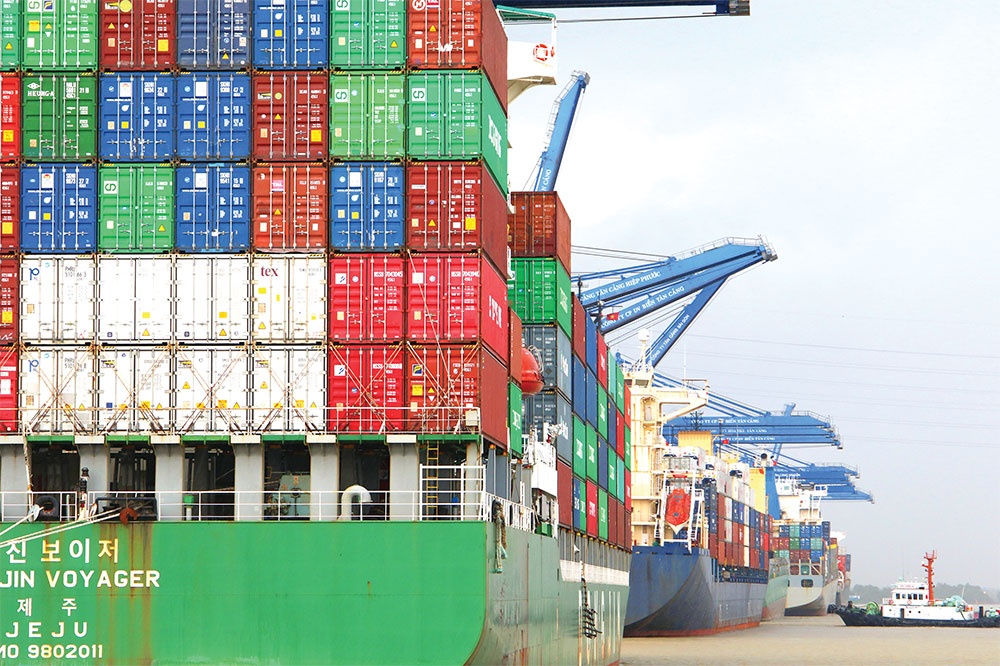Economies evolve China+1 strategy
Southeast Asian countries are seen to benefit in terms of manufacturing investments amid the ongoing friction between China and the United States, according to think tank Oxford Economics last month.
 |
| The demand for shipping containers has declined amid the peak season, photo: Le Toan |
In its research, Oxford Economics said it expects Southeast Asian countries to be a key beneficiary as firms continue to adjust and diversify some production away from China.
“The region is already well established in global and regional supply chains. And it looks set to remain an attractive destination for export-orientated foreign direct investment (FDI) given its labour dynamics, improving quality of infrastructure, and openness to trade,” Oxford Economics said.
In particular, it added that the share of Southeast Asian economies such as the Philippines, Indonesia, Malaysia, Thailand, Singapore, and Vietnam (or ASEAN-6) in global inward FDI averaged around 11 per cent over the past five years, up from 6 per cent over 2012-2017.
The report noted that ASEAN has benefited from trade decoupling between the US and China which started after the US raised tariffs on Chinese imports in 2018.
While China remains the US’ biggest supplier of imported goods, its share dropped to 17 per cent in the first half of the year from about 21 per cent. China’s share of US electronics imports is also down by 5.5 percentage points.
While ASEAN is expected to become an increasing source of global manufacturing and exports, breaking the global and regional dependence on China could require a significant drop in the reliance on backward integration with the Chinese industry.
Reducing dependence on China is deemed easier for some products such as furniture, clothing, and household goods which are labour-intensive. But for other products, China is seen to remain a key manufacturing hub.
“To compete more broadly with China as a production base, ASEAN will need a much larger increase in investment, both foreign and domestic,” Oxford Economics said.
Even with rising labour costs, it said China would still be an attractive destination for FDI given its higher quality of infrastructure and large and skilled labour force. As such, firms are still likely to adopt a China+1 strategy and reduce dependence on China only marginally.
This shift of Asian economies making gains in manufacturing was noted by Takehiko Nakao, chairman of the Mizuho Research Institute and former president of the Asian Development Bank. He said that industrialisation, technological development, demographic dividend, and globalisation have driven Asia’s rise.
“There is no such thing as an Asian consensus but effective policies, strong institutions, governments’ decisiveness in introducing reforms, an ability to learn, and a clear vision for the future often championed by forward-looking leaders have mattered,” said Nakao.
Decoupling supply chains
While diversification is still clearly on the agenda of many major players, recent research has demonstrated that it is easier said than done.
Last month, a Bloomberg Intelligence report estimated it would take about eight years to move just 10 per cent of Apple’s production capacity out of China, where roughly 98 per cent of the company’s iPhones have been made. Scores of local component suppliers – not to mention modern and efficient transport, communication, and electricity supplies – make it particularly difficult to get out of the world’s second-largest economy.
“With China accounting for 70 per cent of global smartphone manufacturing and leading Chinese vendors accounting for nearly half of global shipments, the region has a well-developed supply chain, which will be tough to replicate – and one Apple could lose access to if it moves,” the report said.
Bloomberg Intelligence said that overall tech industry dependence could be reduced by up to 40 per cent “in most cases” by 2030. Hardware and electronic manufacturers could reduce their reliance on the Chinese market to as much as 30 per cent over the next decade.
While Amazon, HP, Microsoft, Cisco, and Dell depend on China to produce hardware for servers, storage, and networking products, the report added that the extent of their dependence is far below that of Apple.
“Decoupling supply chains can be difficult,” says Steven Tseng, senior technology analyst at Bloomberg Intelligence. “The dominance of Chinese companies in smartphones, chips, and the wider electronics manufacturing services sector poses a particular challenge should the US take action to reduce its dependence on Chinese supply chains. With US market juggernauts like Apple relying almost exclusively on China for its manufacturing and assembly, the path to a decoupling of the two countries’ supply chains would be long and arduous.”
Deciding how to deal with operations in China is now made more complex with the events occurring in Europe and Russia.
Divam Sharma, founder of Green Portfolio, noted that the China+1 model gave the EU, Mexico, Taiwan, and Vietnam a boost because companies began investing in these alternate locations. India was also at an advantage since multinationals started investing in emerging countries and India was a viable option because of its low production cost and favourable business environment.
But there are fears that companies might start to disinvest across Europe because of poor gas supply, Sharma said. “This may cause blackouts and shortages all through winter and factory shutdowns. This will eventually lead to lower production and supply chain disruptions thus causing losses for companies with manufacturing units across Europe.”
Many big chemical players have confirmed that they have already started experiencing a hit, and plants are running at low capacity in Europe.
All in all, Europe began to record record-high inflation at the beginning of the Russia-Ukraine war. The permanent shutting off of Nord Stream 1 has exacerbated the problem. Thus, high gas prices and inflation all across Europe might scare off investors, possible meaning an advantage for the likes of Vietnam and India if investors are sufficiently attracted towards investing there instead, Sharma concluded.
Pros and cons
As well as in tech and oil and gas, other sectors are seeing major shifts due to China’s ongoing tussle with the coronavirus pandemic.
The demand for shipping containers has declined amid the peak season. August alone saw a 36 per cent increase in average container prices and 21 per cent increase in one-way leasing rates in Southeast Asian countries, according to Hellenic Shipping News.
This trend of rising container prices and leasing rates validates the strategy of China+1 by companies as the demand for containers rises in Vietnam, Malaysia, and Singapore, among other South Asian countries, it added.
Christian Roeloffs, co-founder and CEO of Container xChange, said, “The growth of containerised trade in Southeast Asia indicates a favourable trade environment for shippers and exporters in the region. For global container shipping companies that are looking to diversify their cargo trade lanes from linear to more diversified routes, countries like Malaysia, Vietnam, and Singapore are emerging as strong contenders, more so for a China+1 strategy in the long term.”
One area that could be holding back Southeast Asian nations, and India, from capitalising is the lack of research and development (R&D) activities.
Vishal Chaudhary, co-founder of Zetwerk, last month noted that China’s contribution to R&D spending was 2 per cent 25 years back, and it has gone to 27 per cent in 20 years. “But India’s has only moved from 1.8 to 2.9 per cent in the same period. So, how do countries like India expect to compete with China when the R&D spending is not there? This is where countries like Germany and Japan have invested in developing those technologies,” he said.
But in the context of global supply chain woes and geopolitical tensions between China and the US, Vietnam is still drawing increased interest for its potential to develop further as an international trading and manufacturing hub. Canadian-born Marina Tran Vu, founder of Vietnam-based sustainable startup brand Equo, thinks China+1 is still going strong. In April, Equo raised $1.3 million in seed funding from NextGenVentures, East Ventures, and others.
“I think people are looking outside that powerhouse of a country for other opportunities. Vietnam just seems like a natural ‘next in line’ country based on the same sort of trajectory,” she said.
Agreeing with that sentiment are John Walsh, director of English at Krirk University Thailand and Trung Quang Nguyen, head of Management at RMIT University Vietnam. Writing for the East Asia Forum last month, the pair noted that Vietnam’s consistent efforts to provide a safe and welcoming environment for foreign business, through the likes of special economic zones, ensure that companies have access to a local workforce in favourable conditions.
“Vietnam’s connectivity with other countries stems from its willingness to become a more active global citizen. Despite starting the connectivity process later than its ASEAN neighbours, Vietnam is catching up with its regional peers in the number of free trade agreements it has signed – the country has joined about every bilateral, multilateral, and transnational organisation and agreement for which it is eligible,” they wrote.
Despite Vietnam’s success in attracting investment, the pair added, it faces competition. Countries like the Philippines, Indonesia and Bangladesh also have large labour forces - offering them competitiveness through low labour costs, they warned.
 | Vietnam stands to win as “China+1” gains traction Changes in the global supply chain are taking place due to the virus outbreak, prompting a mounting number of foreign manufacturers to speed up their relocation from China to neighbouring countries including Vietnam. |
 | China to fine ride-hailing giant Didi more than $1 bn: reports China is preparing to hit ride-hailing giant Didi with a fine of more than $1 billion to wrap up a long-running probe, media reports said, boosting investor hopes that the country's tech crackdown is winding down. |
What the stars mean:
★ Poor ★ ★ Promising ★★★ Good ★★★★ Very good ★★★★★ Exceptional
Related Contents
Latest News
More News
- Partnerships drive sustainable finance (January 07, 2026 | 09:23)
- FDI inflows reach $38.42 billion in 2025 (January 06, 2026 | 17:55)
- $2.1 billion Nghi Son LNG-fired thermal power plant waits for investor (January 06, 2026 | 17:51)
- GE Vernova powers up Vietnam with first 9HA gas power plant in the country (January 06, 2026 | 16:54)
- Solid finish for manufacturing after volatile year (January 06, 2026 | 08:50)
- Meiko strengthens Vietnam operations with new PCB plants (January 06, 2026 | 08:49)
- Ho Chi Minh City backs $2 billion AI data centre with dedicated task force (January 06, 2026 | 08:43)
- PM sets January deadline for high-speed rail consultant (January 06, 2026 | 08:40)
- New decree spurs on PPP implementation (December 31, 2025 | 19:01)
- Global alliance develops $1 billion AI data centre network in Vietnam (December 30, 2025 | 10:08)

 Tag:
Tag:
















 Mobile Version
Mobile Version